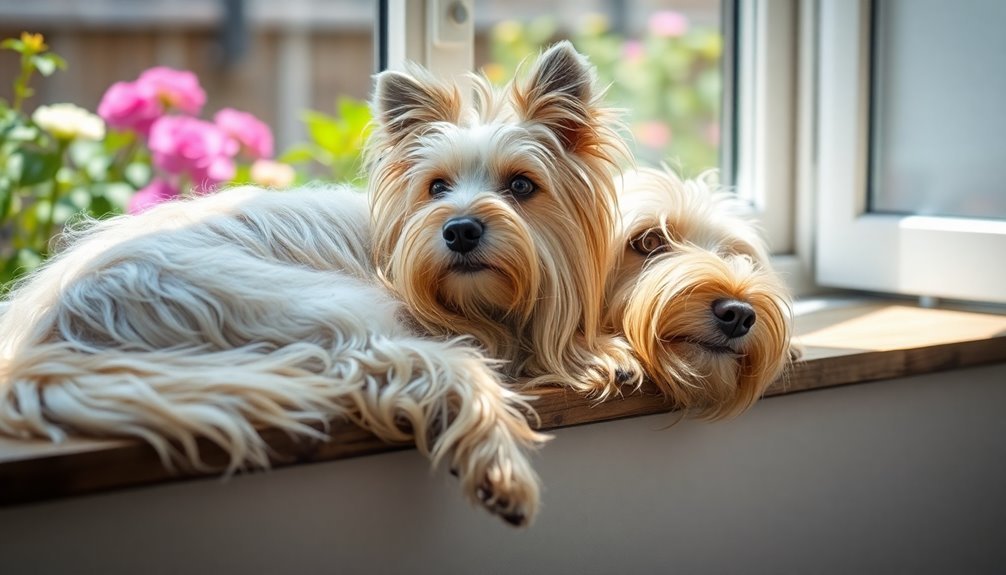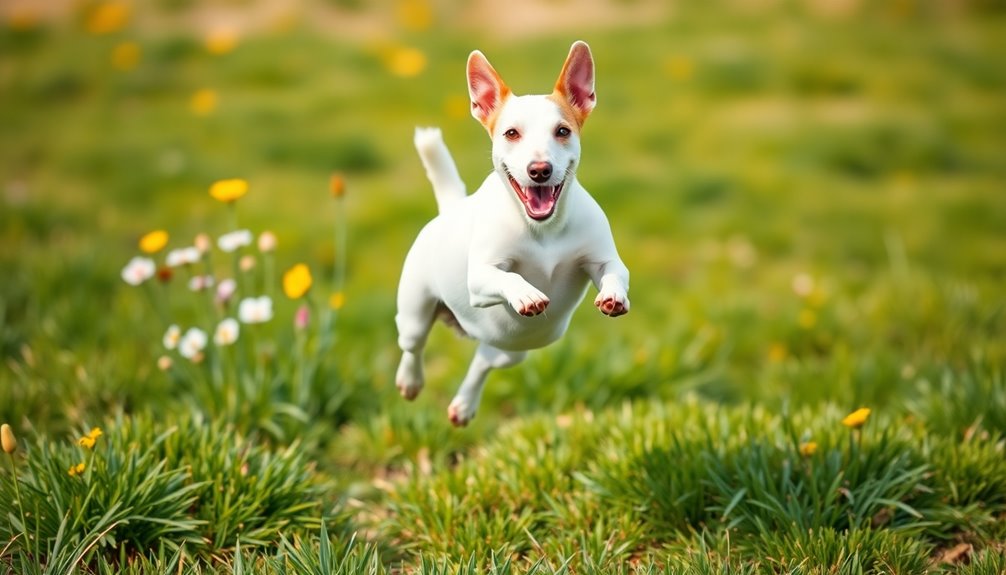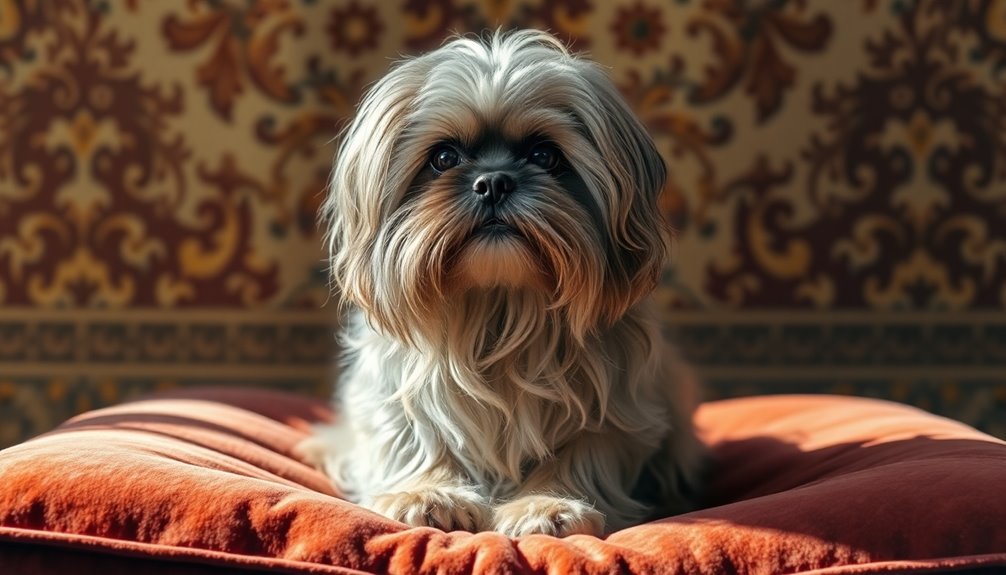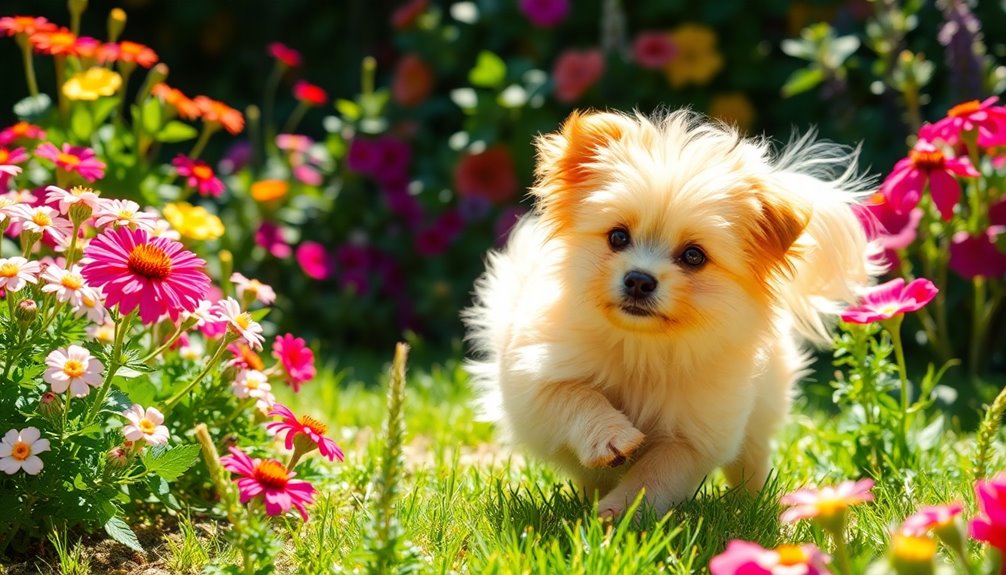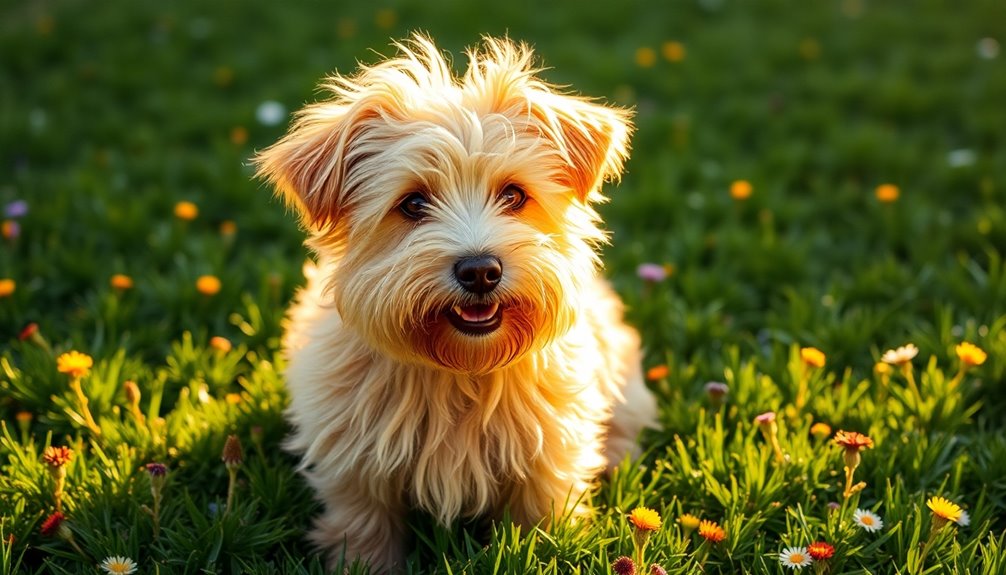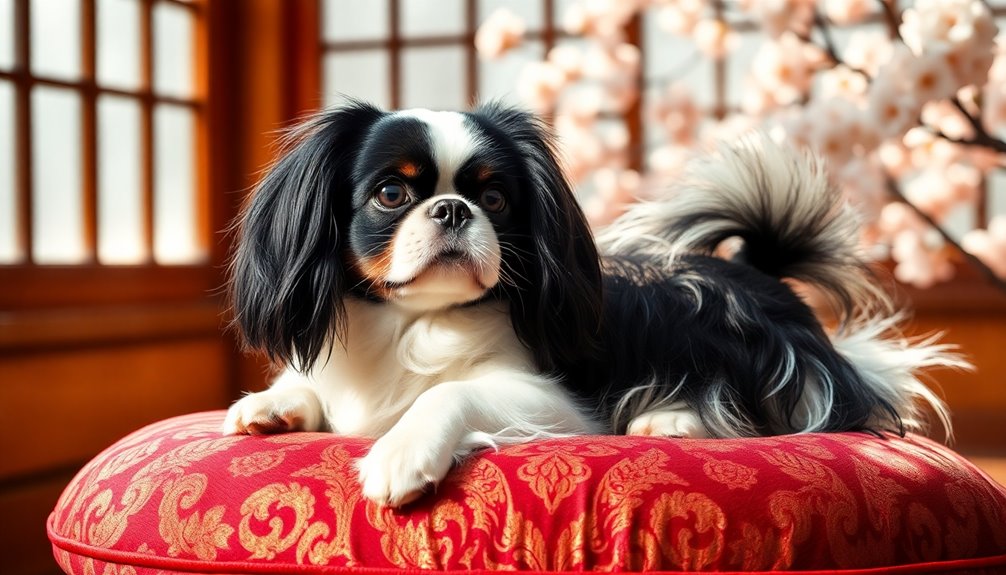The Skye Terrier is a long-coated, loyal companion that's sure to win your heart. Known for their deep bonds with families, these dogs thrive on affection and attention. With a height of 9 to 10 inches and a weight range of 25 to 40 pounds, they have a compact build and striking coat colors like black, blue, and cream. They require moderate exercise, enjoying short walks and playtime. Their unique personalities can make training a challenge, but consistent, positive reinforcement helps them flourish. Keep exploring to uncover more about their fascinating traits and care needs.
Key Takeaways
- Skye Terriers are known for their loyalty, forming strong bonds with their families and providing companionship.
- They feature a long, flowing double coat that requires regular grooming to avoid matting.
- With moderate exercise needs, they enjoy daily walks and short play sessions without overexertion.
- This breed adapts well to various living situations, thriving in both apartments and homes with fenced yards.
- Early socialization and consistent training are essential for their well-rounded temperament and responsiveness.
Introduction
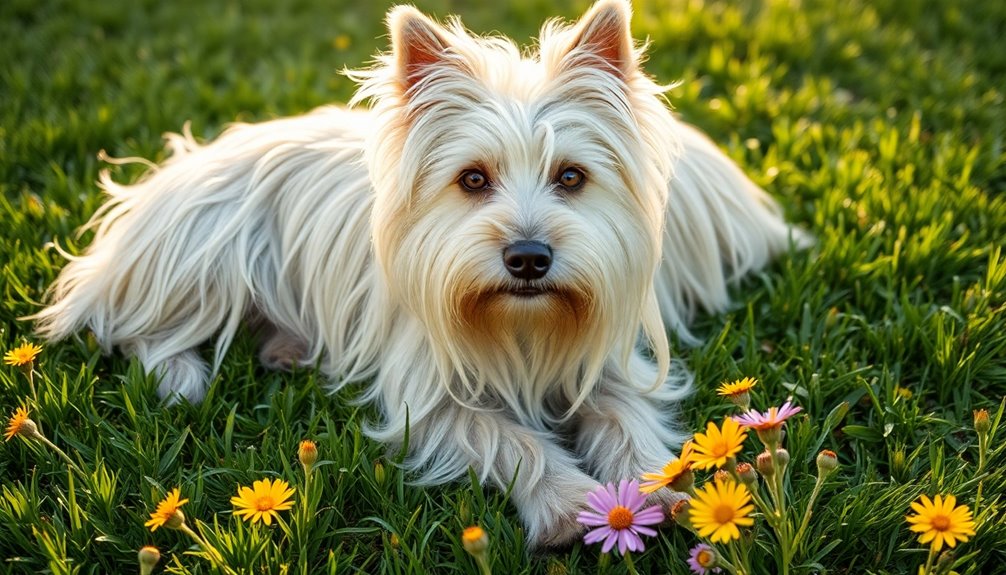
The Skye Terrier is a unique and charming breed, known for its long, flowing coat and loyal disposition. Standing at 9 to 10 inches tall and weighing between 25 to 40 pounds, these dogs have a distinct presence. Males typically tip the scales at 35 to 40 pounds, while females weigh around 25 to 31 pounds. Their silky coat comes in a variety of colors, including black, blue, gray, silver, fawn, and cream, adding to their appeal.
Skye Terriers are fiercely loyal and form deep bonds with their families. Their independent nature can make them a bit stubborn, so you'll need to establish consistent training. They're alert and protective, making them great watchdogs, but early socialization is essential to manage their suspicion of strangers. This breed is classified as a terrier, which contributes to their spirited and feisty personality.
Although they generally get along with children, they prefer quiet and gentle interactions. With an average energy level, Skye Terriers require less than 30 minutes of exercise daily, making them suitable for apartment living. However, be cautious around other small animals, as they love to chase.
Regular grooming is vital to keep their coat in good shape and prevent matting.
History and Origin
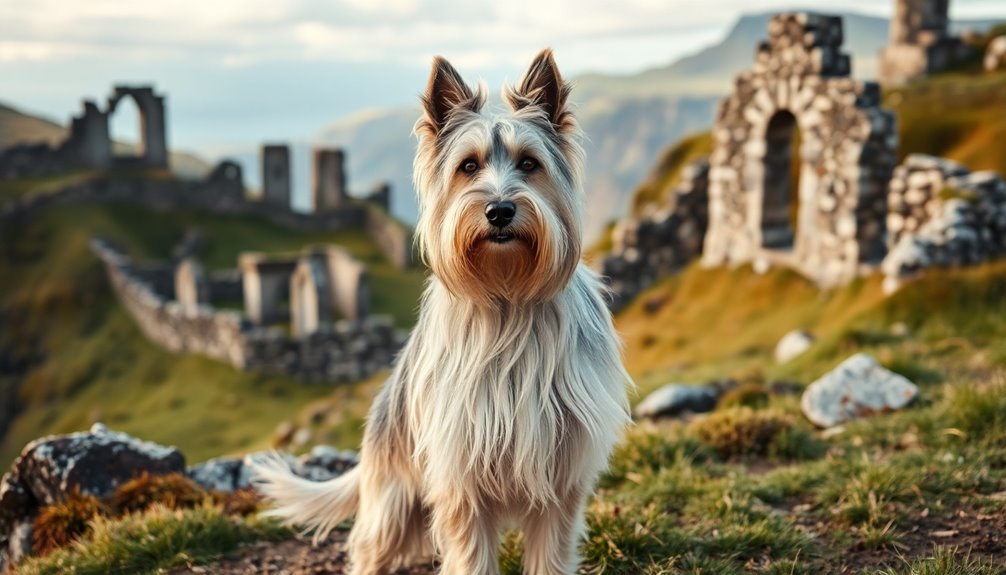
The Skye Terrier traces its roots back to the rugged Isle of Skye in northwestern Scotland, where it emerged as a skilled hunter of burrowing game. This breed adapted to the rocky terrain and harsh conditions, showcasing its tenacity and determination. Recognized for its historical and cultural heritage, the Skye Terrier has maintained its distinctive features for over 400 years. Understanding its historical context helps you appreciate the Skye Terrier's unique characteristics and charm.
Where and when the breed originated
Originating from the rugged landscapes of the Isle of Skye in northwestern Scotland, the Skye Terrier boasts a rich history that dates back at least 400 years.
This breed's roots trace back to the 1500s, with documented presence on the Isle of Skye prior to 1588. The unique environment of the Inner Hebrides shaped the Skye Terrier, influencing its development through the harsh conditions of the region.
The early settlers, including the Picts from Ireland and later the Vikings, played a crucial role in the breed's evolution. It's likely that the Vikings brought similar breeds from Scandinavia, contributing to the Skye Terrier's distinctive body shape and characteristics.
As time progressed, the breed gained popularity among British royalty, particularly during the mid-16th century and later in the Victorian Era.
Queen Victoria's affection for the Skye Terrier helped solidify its status among the aristocracy, and notable figures like Mary Queen of Scots are believed to have favored this loyal companion.
The breed's acceptance in royal circles and its presence in early dog shows further showcased its esteemed position in society. Additionally, the Skye Terrier is currently listed as one of the UK's most endangered dog breeds, highlighting the importance of preservation efforts for this historical canine.
Burrowing Game in Rocky Terrain
Bravery and resilience define the Skye Terrier's role as a skilled hunter in rocky terrain, where its burrowing game instincts shine. Bred specifically to hunt farm vermin like badgers, otters, and foxes, these dogs were essential for protecting farms from pests. Their long, thick coat not only made them appear larger and more intimidating but also shielded them from bites while they navigated through dense undergrowth.
The Skye Terrier's low-slung build allows it to follow small game into burrows, showcasing its natural digging instinct. Weighing between 25-35 pounds, their distinctive body shape—twice as long as they're tall—facilitates easy movement underground. With a powerful body and punishing jaws, these fearless hunters can go to ground on quarry like foxes or badgers. This breed's popularity has significantly declined from their royal favor, making them one of the UK's most endangered dog breeds.
While their independent and stubborn nature can make training a challenge, it also contributes to their resourcefulness as hunters. Loyalty to their owners is a key trait, though they may appear aloof with strangers.
Physical Characteristics
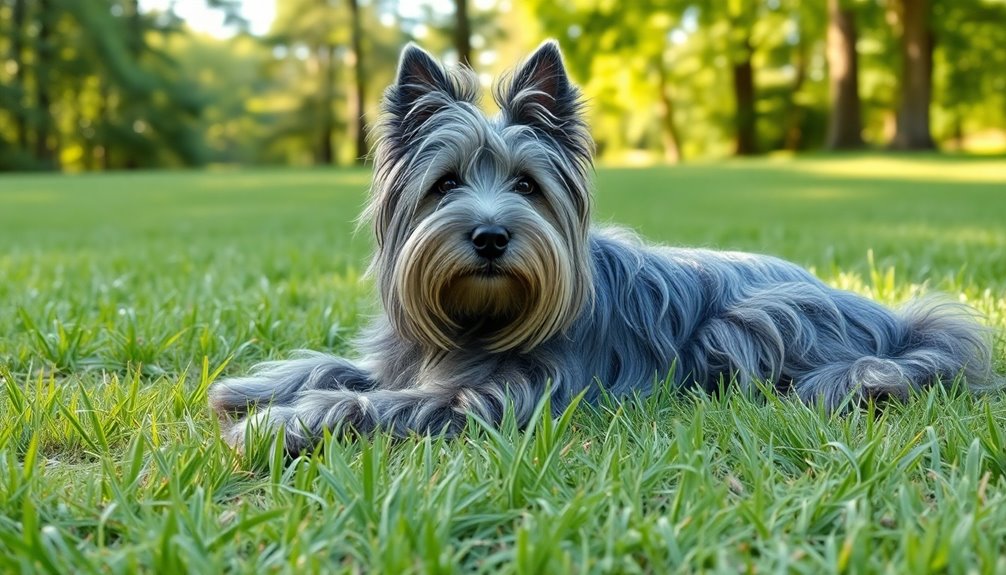
When you look at a Skye Terrier, you'll notice their compact size, standing between 9 to 10 inches at the shoulder and weighing between 25 to 40 pounds.
Their long, flowing, shaggy coat not only adds to their charm but also requires regular grooming to keep it looking its best. Additionally, they have a thick double coat that provides protection against harsh weather, making them well-suited for their original Scottish habitat.
This unique combination of size and coat makes them stand out in the dog world.
Size, weight, and coat details
The Skye Terrier's compact build and sturdy structure make it a unique breed among terriers. Standing between 9 to 10 inches tall, males typically reach around 10 inches, while females measure about 9 to 9.5 inches. By the time they're one year old, they've reached their adult height.
When it comes to weight, Skye Terriers range from 25 to 40 pounds. Males usually weigh between 35 and 40 pounds, while females are lighter, falling in the 25 to 30-pound range. You'll notice that the most rapid growth occurs in the first six months. Maintaining a population of 3,000 to 4,000 globally is crucial for the breed's conservation.
Their body type is long and level, keeping them low to the ground with short, muscular legs that support a long torso. Thickly-padded feet provide stability and comfort as they move.
The breed features powerful heads, deep chests, and well-developed hindquarters, giving them a solid appearance. Depending on the individual, ears may be drop or prick, and their brown eyes are frequently obscured by long hair.
With color variations including blond, fawn, silver, blue, grey, and black, Skye Terriers are both distinct and delightful companions.
Long, Flowing, Shaggy Coat
With a long, flowing coat that exudes elegance, Skye Terriers are truly a sight to behold. Their double coat features a straight, flat-lying outer layer that's long and silky, complemented by a soft, insulating undercoat. This luxurious texture not only enhances their appearance but also provides protection from harsh weather, allowing them to thrive in various conditions.
The coat comes in beautiful shades of black, gray, fawn, and cream, often with distinctive black points on the ears and muzzle. To keep this stunning coat looking its best, regular grooming is essential. You'll need to brush your Skye Terrier at least once a week, paying extra attention to areas prone to tangling, like behind the front legs.
Using long-toothed combs and pin brushes will help prevent matting without the need for scissoring. Bathing frequency varies based on lifestyle, and using oatmeal shampoo and conditioner can minimize coat breakage. Additionally, keeping the fur trimmed between their pads is vital for hygiene and mobility. With consistent care, your Skye Terrier's flowing coat will remain a beautiful testament to their breed's elegance.
Temperament and Personality
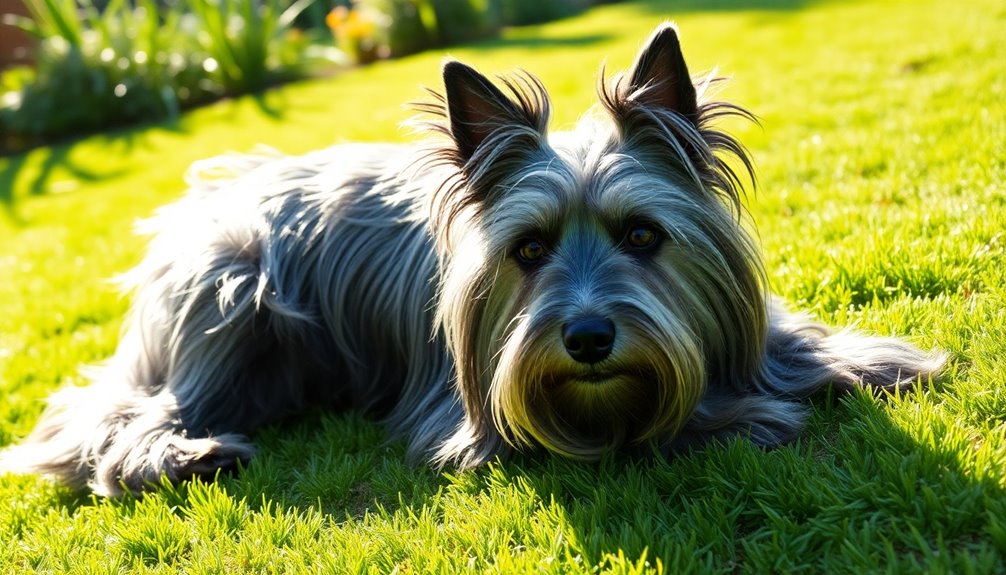
When you bring a Skye Terrier into your home, you're welcoming a devoted and protective companion. Their affectionate nature makes them suitable for families and individuals alike, as they thrive on close relationships. With proper socialization, they can even get along well with other pets, adding to their charm as a versatile family member. Their strong-willed personality can also make training a rewarding challenge, requiring patience and positive reinforcement.
Devoted and Protective Nature
Skye Terriers are known for their unwavering loyalty and protective instincts, making them exceptional companions. You'll quickly notice how deeply they bond with their family members, often forming an intense one-on-one relationship with a single owner. Their affectionate nature means they love to cuddle and spend quality time with you, demanding plenty of affection in return.
When it comes to protection, Skye Terriers excel as alert watchdogs. They're naturally wary of strangers and won't hesitate to react defensively if they perceive a threat, showcasing their courageous spirit. Their moderate barking serves as a helpful alert, informing you of any unusual sounds or visitors. Their moderate shedding means regular grooming is necessary to keep their coat healthy and beautiful.
While they may appear reserved at first, this behavior reflects their confidence rather than shyness.
However, it's important to remember that their protective instincts can lead to territorial behavior if not properly trained and socialized. Early socialization is crucial to help them adapt to various social settings and to manage their independent streak.
With the right guidance, your Skye Terrier won't only be a devoted companion but also a steadfast protector of your home and family.
Suitability for families, individuals, or other pets
Families, individuals, and even multi-pet households can find a great companion in a Skye Terrier, provided they understand the breed's unique needs.
They're best suited for families with older children, as their temperament may be too strong for kids under six. Supervise interactions to prevent any accidents, and encourage gentle play styles. Early socialization is crucial for them to thrive around children.
For individuals, Skye Terriers require plenty of attention and affection. They adapt well to both large and small living spaces, but they need regular exercise to stay happy and healthy. Ongoing training with positive reinforcement is essential, especially as they can be reserved around strangers. Their high exercise needs mean that daily walks and playtime are vital for their well-being.
In multi-dog households, Skye Terriers can coexist harmoniously if introduced and socialized properly. They typically have a friendly disposition towards other dogs, but monitor their interactions, especially with smaller pets.
Due to their high prey drive, they're not suitable for homes with small animals like rabbits or hamsters. While they may get along with cats if raised together, caution is advised. Always supervise interactions with smaller pets to ensure everyone's safety.
Health and Lifespan

Understanding the health and lifespan of your Skye Terrier is essential for ensuring they thrive. This breed typically lives between 12 to 14 years, but some can even reach 15 with the right care. You should be aware of common health concerns and genetic predispositions to maintain their well-being effectively. Regular monitoring for behavioral changes is essential, as they can indicate potential health issues.
Typical lifespan of the breed
When considering the typical lifespan of a Skye Terrier, you'll find that these dogs generally live between 12 to 14 years, with some reaching up to 15 years. This longevity is quite impressive, especially for a medium-sized breed, and reflects the breed's overall health. Your Skye Terrier's lifespan can be influenced by several factors, including proper care, a balanced diet, and regular veterinary check-ups. To help your furry friend live a long, healthy life, you'll need to ensure they get moderate exercise, particularly during their first year to avoid bone issues. A balanced diet that meets their energy needs at different life stages is crucial, as a species-appropriate diet can significantly enhance their overall health. Grooming is also important; their long, silky coat requires regular attention to stay in top condition. Environmental factors play a role too—Skye Terriers thrive in cooler climates, so keep an eye out for parasites and skin concerns. Regular veterinary visits and screenings are recommended to catch any potential health issues early.
Common health concerns or genetic predispositions
Skye Terriers can face a range of common health concerns and genetic predispositions that owners should keep an eye on. One significant issue is patella luxation, where knee caps can pop in and out of place, sometimes requiring surgery to prevent arthritis.
You should also be aware of skin issues, including allergies and infections, which often necessitate chronic medications and special diets. Regular monitoring for ear infections is essential, as Skye Terriers can be prone to these as well. Hyperthyroidism and autoimmune diseases are additional concerns that could impact their overall health.
Musculoskeletal problems, such as hip dysplasia and degenerative disc disease, are common due to their unique body structure. Additionally, some conditions can be life-threatening if untreated, making it crucial to watch for signs of arthritis and joint injuries, especially if your dog is overweight. Furthermore, keep an eye on liver health, as chronic hepatitis can arise from genetic factors and in-breeding practices.
Eye problems and the risk of aggressive cancers, like hemangiosarcoma, further complicate their health profile. Regular grooming is vital for detecting parasites, and spaying or neutering can help prevent reproductive health issues. Regular vet check-ups are essential for early detection of health issues, so don't overlook this vital aspect of your Skye Terrier's care.
Tips for maintaining health and wellness
Maintaining the health and wellness of your Skye Terrier is essential for a long and happy life together. Start by providing a high-quality diet tailored to your dog's age, size, and energy level. A balanced diet should include proteins, carbohydrates, fats, vitamins, and minerals. Consult your veterinarian to find the best food for your pup, and choose nutritious treats that also benefit dental hygiene. Avoid overfeeding to keep your dog at a healthy weight.
Daily exercise is crucial; aim for 20 to 30 minutes of walking. This not only keeps your dog physically fit but also prevents undesirable behaviors. For puppies, limit exercise to avoid bone growth issues. Additionally, regular exercise helps prevent common health issues that Skye Terriers may face.
Mental stimulation is equally important, so engage your Skye with toys and activities.
Grooming should happen several times a week to remove tangles and debris, using a pin brush and comb. Regular check-ups with your vet are key to monitoring health and screening for conditions like skin allergies and hip dysplasia.
Pay attention to any changes in behavior or energy levels, and don't hesitate to seek professional advice when needed. Your efforts in these areas will greatly contribute to your Skye's overall health and longevity.
Care Requirements
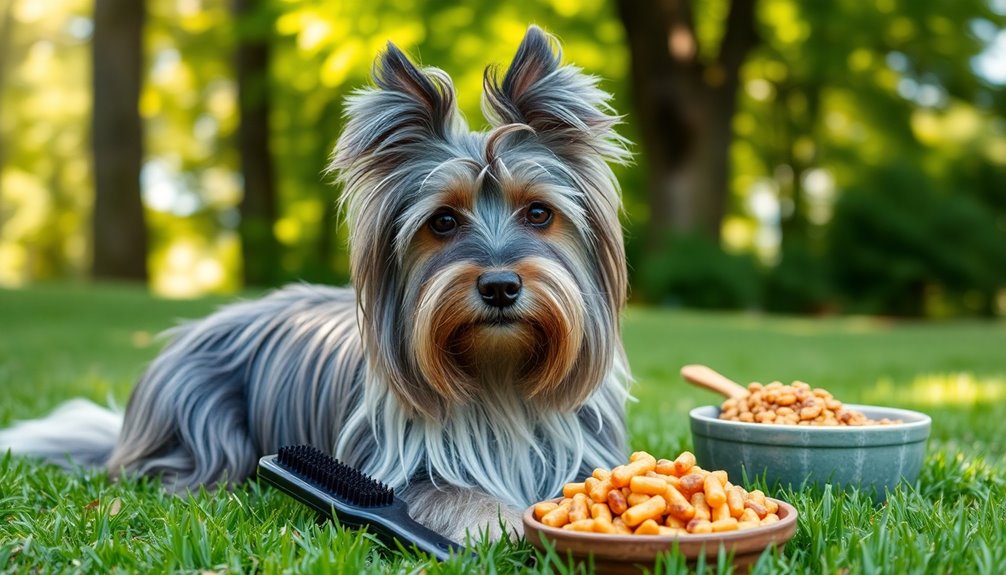
Caring for your Skye Terrier involves regular brushing to keep that beautiful coat healthy and free of mats. Additionally, it's important to incorporate routine maintenance for their nails, ears, and teeth to ensure their grooming needs are fully met. You'll also need to ensure they get enough exercise, as their energy levels require daily activity to stay happy. Lastly, paying attention to their diet is crucial for maintaining overall health and well-being.
Regular Brushing Required
Regular brushing is essential for keeping your Skye Terrier's coat healthy and free of tangles. You'll want to brush your dog at least once a week, but more frequent sessions can help prevent tangling and matting.
Brushing not only removes dead hair but also reduces shedding, making your home cleaner. Focus on areas that tend to tangle, like behind the front legs. Use a pin brush and a long-toothed comb for effective grooming.
When brushing, be gentle, especially if the coat is damp or dry, to avoid causing matting. Trim the hair around the feet to help with movement and prevent mats, but avoid using force, as this can lead to breakage.
While you can keep your Skye's coat clipped short for easier maintenance, it's not necessary. Occasional trimming keeps the coat looking its best. Regular grooming also helps prevent flea and tick infestations and painful skin conditions. Remember to check your dog's ears and teeth during grooming sessions to ensure overall health.
With consistent care, your Skye Terrier will have a beautiful, healthy coat that reflects their loyal nature. Additionally, maintaining their coat is crucial for their weather-resistant double coat, which protects them from the elements.
Exercise requirements and energy levels
A well-groomed Skye Terrier also needs balanced exercise to keep them healthy and happy. These dogs require moderate exercise, which includes daily walks and short play sessions. Avoid long walks or vigorous activities, as they can lead to overexertion and back injuries. A fenced yard is ideal for allowing your Skye to run and play safely, but apartment living works too if you commit to two or three short walks each day.
Skye Terriers aren't high-energy dogs, but they still need regular activity to stay physically and mentally fit. They love to explore their surroundings and sniff out new scents, keeping their minds engaged. In fact, as one of the UK's most endangered dog breeds, maintaining their health through proper exercise is crucial for their longevity.
While puppies have higher energy levels, it's crucial to manage their activities to prevent excessive exertion and injuries. Due to their elongated spines, Skye Terriers should avoid jumping onto hard surfaces or climbing stairs. Use ramps or carry your puppy as needed to protect their growing bodies.
Short, controlled play sessions are the best way to keep your Skye active while minimizing injury risks. Variety in their routine can help keep them engaged and content.
Feeding tips and diet recommendations
Feeding your Skye Terrier with a balanced diet is essential for their overall health and well-being. Start by providing high-quality protein from animal sources like beef, chicken, or fish, as these are crucial for muscle development. Incorporate essential fatty acids and omegas to support their coat and skin health. A small amount of carbohydrates from vegetables, herbs, and berries can add valuable nutrients and fiber. Aim for a diet that mimics their natural eating habits, focusing on meat, bones, and offal. Include some plant ingredients for prebiotics and antioxidants. Additionally, consider using recipes created by canine nutrition experts to ensure optimal nutrition for your dog's unique needs nutritional quality. Make sure to avoid low-quality fillers and preservatives. Depending on your Skye's life stage—puppy, adult, or senior—you'll need to adjust their diet and feeding frequency. Adults typically eat twice a day, while puppies may need more frequent meals. Keep an eye on their weight and activity level, adjusting portions as necessary. Treats should be given in moderation, and opt for natural, preservative-free options. You might also consider supplements for specific health needs. Always consult your veterinarian for personalized feeding plans tailored to your companion's unique requirements.
Training and Socialization
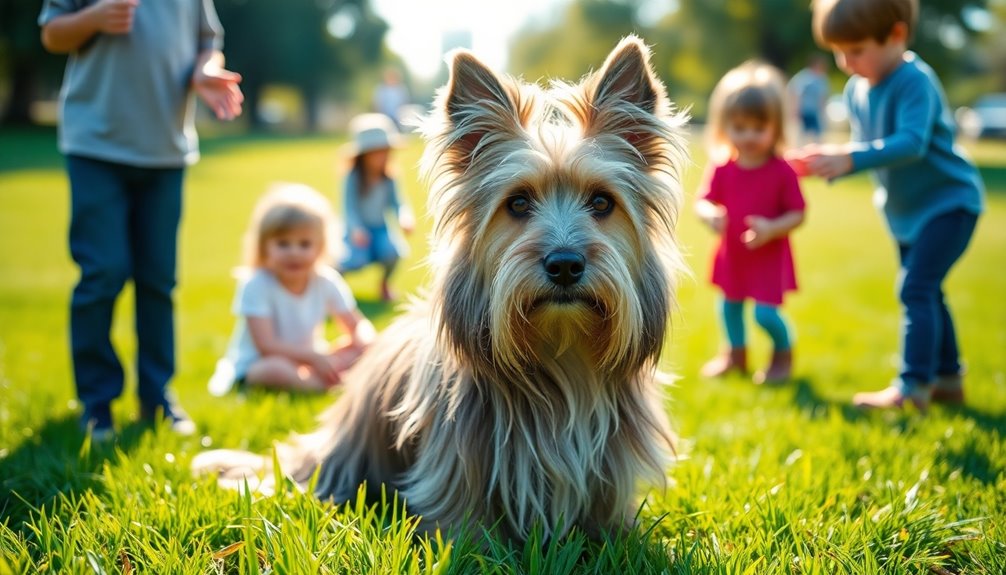
When training your Skye Terrier, you'll find they're moderately responsive to commands, but consistency is key. Gradual introductions to new friends help them feel secure and comfortable in social situations. You might also notice some leash pulling during walks, so incorporating leash training techniques will make outings more enjoyable for both of you. To support their training, consider using positive reinforcement methods, as they can greatly enhance your Skye Terrier's learning and behavior.
Moderately Responsive to Commands
Skye Terriers can be a delightful challenge when it comes to training, as they're intelligent yet often stubborn. You'll find that they can excel in basic obedience, but their independent nature might test your patience. To get the best results, use positive reinforcement techniques like praise, treats, and play. This approach not only motivates them but also fosters a strong bond between you.
Consistency and patience are crucial; firm yet fair guidance will yield better outcomes. Mixing up your training sessions keeps them engaged and prevents boredom. Avoid drilling them with repetitive commands, as this can be counterproductive. Instead, introduce varied exercises that stimulate their minds. Additionally, their unique independence and loyalty make them capable of excelling in competitive obedience and agility events.
Although they're quick learners, remember that Skye Terriers are sensitive to correction. Treat them with kindness and respect to ensure a positive experience. Integrating training into daily life helps make these lessons feel natural, promoting a smoother learning curve.
As you work together, consider activities like Rally Obedience, which strengthens your connection through teamwork. With consistent training and socialization, you'll nurture a loyal companion that's responsive and well-adjusted.
Gradual Introductions to New Friends
Creating a welcoming atmosphere for your Skye Terrier is essential when introducing them to new friends, whether they're people or other pets. Start socializing your puppy between 3-5 weeks of age to help them develop a playful and tolerant demeanor. Expose them to various people of different ages, sizes, and backgrounds to build their confidence and adaptability. Additionally, early socialization can help mitigate anxiety and depression in your pet, similar to how pet therapy benefits individuals with cognitive impairments.
When introducing your Skye Terrier to other pets, take it slow. Use pet gates to create safe spaces and allow your cat or other small pets to escape to higher areas if necessary. Keep interactions short and supervise closely, rewarding good behavior with treats and praise. Remember, Skye Terriers have a strong prey drive, so consistent supervision is crucial to avoid chasing behaviors. Gradual introductions are recommended to lead to better outcomes for both pets.
Additionally, expose your Skye Terrier to new environments, sounds, and experiences to prevent fearful reactions. Short walks and backyard playtime can help introduce these new stimuli gradually. Regular exposure to different situations can also enhance their resilience, similar to the benefits seen in pet therapy for patients with dementia.
Ongoing socialization is vital for maintaining their confidence throughout life. Utilizing positive reinforcement during these experiences encourages a balanced personality, ensuring your Skye Terrier remains a loyal and loving companion.
Leash Pulling During Walks
Leash pulling is a common challenge for many dog owners, and it can be particularly frustrating during walks. To tackle this issue, start with basic training. Commands like "sit," "stay," and "come" create a solid foundation, making leash training easier. Consistency is key, so practice in a distraction-free area to reinforce learning. Additionally, focusing on small mistakes during training can lead to significant improvements.
Consider using a no-pull harness, which applies pressure to your dog's chest, discouraging pulling. Brands like Rabbitgoo are highly rated and can be a safer alternative to traditional collars. Avoid equipment that may cause harm or discomfort.
When your Skye Terrier pulls, stop walking immediately and wait for them to return to your side. Use positive reinforcement—treats, praise, and affection—to reward good behavior. This helps them associate walking nicely with positive outcomes. Positive reinforcement is essential as it creates positive associations with the desired behavior.
Remember, punishing them for pulling can increase anxiety and frustration.
If you're struggling, online dog training courses offer personalized advice and techniques like "Slow Stop" and "Body Bubble." Short, focused training sessions are effective, and gradually introducing distractions will bolster your leash training efforts.
With patience and the right approach, you'll both enjoy your walks much more.
Ideal Living Environment

If you're considering a Skye Terrier, a spacious home with outdoor access is ideal for their well-being. They thrive in cooler, temperate climates, making it important to create a comfortable environment that suits their needs. With a bit of room to roam, your Skye can enjoy both playtime and relaxation. Regular exercise is crucial for maintaining their health and preventing back injuries due to their elongated spine.
Spacious Home With Outdoor Access
A Skye Terrier's ideal living environment combines comfort with accessibility, allowing them to thrive in both small and spacious homes. While they're adaptable and can comfortably reside in apartments, they still need space to move and exercise. A small to moderate-sized yard is beneficial but not a strict requirement. You can keep them active with indoor play and frequent short walks, which are usually sufficient for their physical needs.
Outdoor access is crucial for their well-being, providing opportunities for short walks and play sessions. A fenced-in yard is ideal to ensure their safety while preventing escape or injury. When outdoors, you should avoid activities that stress their elongated spines, such as jumping or climbing stairs. Supervision is key to preventing potential back injuries. Additionally, the Skye Terrier's long, low structure requires careful monitoring to prevent injuries during playtime.
Moreover, your Skye Terrier thrives on social interaction, so regular engagement with you is essential. Early socialization helps them develop a friendly personality, reducing aloofness towards strangers.
Prefers Cooler, Temperate Climates
Skye Terriers thrive in cooler, temperate climates where they can comfortably enjoy outdoor activities without overheating. Their thick double coat makes them ill-suited for extreme heat, which can lead to discomfort and health issues. In fact, they tolerate cold weather much better than hot weather, but they still need protection from harsh conditions.
To keep your Skye Terrier content, ensure they've moderate outdoor exposure, ideally around 30 minutes of exercise daily. Daily walks are essential, even in cooler temperatures. While these dogs have a moderate energy level, they still need engaging activities like walking or running to stay healthy. Additionally, Skye Terriers are known for their devoted nature, making them excellent companions during outdoor adventures.
Balance outdoor play with indoor rest to prevent excessive fatigue. Grooming is another important aspect of their care in cooler climates. Regular weekly brushing is necessary to prevent matting of their long, flowing coat. You might consider clipping their coat short for easier maintenance, especially during shedding seasons.
Behaviorally, Skye Terriers feel more at ease in cooler temperatures, which can reduce restlessness. They're loyal and devoted companions, but socialization is crucial to help them adjust to new situations and people.
Famous for Their Hunting Skills
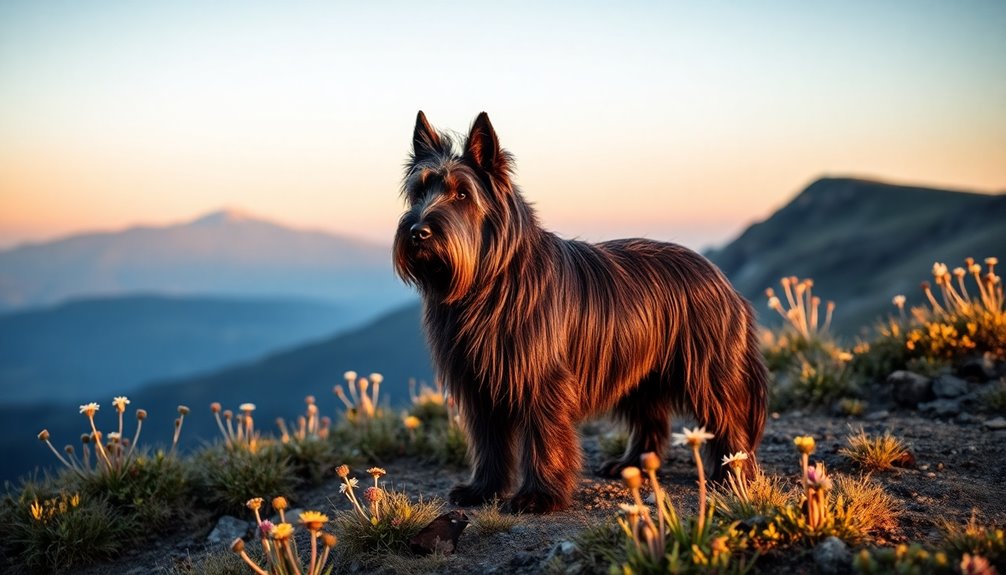
When it comes to their hunting skills, Skye Terriers communicate in unique ways, often rarely barking. Their rich history in Scottish folklore highlights their bravery and tenacity as hunters. You'll find that these traits make them fascinating companions, blending a fierce spirit with a loyal heart. Additionally, with proper training, they can be taught to locate game effectively, enhancing their performance in the field.
Rarely Barks, Communicates Differently
Known for their keen senses and hunting prowess, Skye Terriers rarely bark, choosing instead to communicate through more subtle means. While they may bark to alert you of potential threats or when playing, they generally maintain a quiet demeanor. This trait reflects their instinctual wariness of strangers, making them excellent guard dogs. Their historical role as working terriers ensured they developed a courageous nature, keeping an eye on their surroundings and ready to alert you to any perceived dangers. Their protective instincts stem from their history as hunters of foxes and badgers. This background not only contributes to their alertness but also to their independent and fearless personalities.
While they've strong instincts, training and socialization play crucial roles in ensuring they behave appropriately. Early, consistent training with positive reinforcement can help minimize excessive barking and manage their territorial behavior.
Skye Terrier in Scottish Folklore
The rich history of the Skye Terrier reveals its deep roots in Scottish folklore, particularly celebrated for its remarkable hunting skills. Originating from the Isle of Skye, these dogs date back to at least the 14th century, making them Scotland's oldest terrier breed. They were bred to tackle pests like badgers, foxes, and otters, showcasing their tenacity and fearlessness. Their historical significance is further highlighted by their connections to notable clans like the Macdonalds and MacLeods.
With short legs and thick paws designed for digging, they excelled in their role as protectors of farms. Their thick double coat allowed them to withstand harsh weather, further enhancing their suitability as working dogs.
The Skye Terrier's prowess in hunting gained them favor among the British aristocracy, including Mary Queen of Scots and Queen Victoria. Their presence in royal kennels and depictions in artworks by Sir Edwin Landseer solidified their status.
Folklore also highlights their loyalty, exemplified by stories like that of Greyfriars Bobby, who guarded his owner's grave for 14 years. These tales illustrate the deep bond between Skye Terriers and their humans, showcasing not just their hunting skills, but also their unwavering devotion and spirited personality.
Active Lifestyle Compatibility
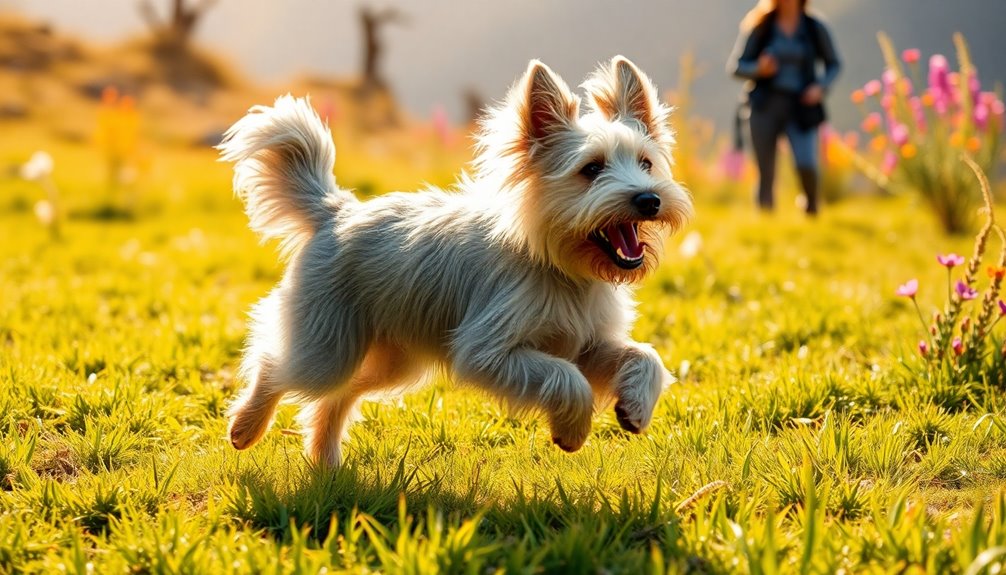
If you lead a dedicated lifestyle, a Skye Terrier can be a great companion.
They're adaptable and will enjoy joining you in moderate activities, but they do need regular grooming and commitment to thrive.
Ideal for Dedicated Owners
Skye Terriers are often perfectly suited for dedicated owners who lead an active lifestyle, as they adapt well to various living environments. With moderate exercise needs, a daily routine of short walks totaling around 30 minutes, combined with play sessions, keeps them happy and healthy. It's important to remember that excessive exercise before growth plate closure can lead to issues like limping, so planning activities with care is crucial.
You'll want to avoid long walks or vigorous activities to prevent overexertion and potential back injuries due to their unique body structure.
Whether you live in an apartment or a house with a fenced yard, Skye Terriers thrive in both city and country settings, provided they've opportunities for play. Nearby parks are ideal for their energetic nature, allowing them to chase and socialize.
Enjoying one-on-one playtime with you is essential, as they love engaging in chasing games or even participating in dog sports.
Keep in mind that while they enjoy being active, their exercise requirements aren't excessively high. Just make sure to monitor their play to prevent injuries, especially in puppies.
Engaging them in low-impact activities ensures they stay fit and content in your lively household. With your dedication, these loyal companions will flourish and bring joy to your active lifestyle.
Grooming Needs and Commitment
Maintaining a Skye Terrier's grooming needs is essential for ensuring their health and comfort, especially for owners leading an active lifestyle. Regular brushing is a must, at least once a week, to prevent matting and keep their coat healthy.
You'll want to brush down to the skin using long-toothed combs and pin brushes with long pins to tackle their heavy coat effectively. Don't forget to pay extra attention to tricky areas, like behind the front legs, where tangles often hide.
Bathing frequency depends on your environment; city dogs might need more frequent baths. When you do bathe them, avoid scrubbing the coat—squeeze or pull the shampoo through instead. Diluting the shampoo can help prevent breakage.
Afterward, you can brush the coat while it dries or let it dry naturally before brushing. It's also important to manage their nails, ears, and teeth regularly.
Keep in mind that Skye Terriers require low to moderate exercise, so short daily walks and playtime at home are ideal. Furthermore, regular health check-ups are recommended to detect any potential breed-related health issues. By committing to their grooming needs, you'll ensure your Skye Terrier thrives alongside your active lifestyle.
Frequently Asked Questions
Are Skye Terriers Good With Children and Other Pets?
Skye Terriers can be great with children, especially if they're gentle and quiet.
These dogs are patient and form strong bonds with their families. However, you should supervise their interactions, particularly with younger kids, to prevent any misunderstandings.
When it comes to other pets, Skye Terriers can get along with well-socialized cats and dogs but may chase smaller animals due to their prey drive.
Always monitor their interactions for safety.
How Much Grooming Do Skye Terriers Require?
Skye Terriers require significant grooming to maintain their long, luxurious coat. You should brush and comb them weekly to prevent matting and tangling.
Bathing about once a month is recommended, using gentle, diluted shampoo. After bathing, you can either brush while drying or let them dry naturally before grooming.
Don't forget regular nail trimming, ear cleaning, and dental care to keep your furry friend healthy and comfortable.
Regular grooming also helps spot potential health issues early.
What Is the Average Weight of a Skye Terrier?
The average weight of a Skye Terrier typically ranges from 25 to 40 pounds.
You'll find that males are generally larger and heavier, often hitting the upper end of this range, while females tend to be lighter.
It's important to track their weight regularly, as this helps you assess their overall health and growth.
Proper nutrition and routine vet check-ups will support their development and keep them within a healthy weight range.
Do Skye Terriers Have Any Common Behavioral Issues?
Yes, Skye Terriers can have some common behavioral issues.
You might notice stubbornness, making training a bit challenging. Their strong prey drive could lead to chasing smaller animals, and they may dig in your garden.
Nuisance barking can also arise, especially if they're bored or poorly socialized. To manage these behaviors, consistent training and positive reinforcement are essential.
Supervision during interactions with children and other pets is crucial to ensure a harmonious environment.
How Can I Keep My Skye Terrier Entertained Indoors?
To keep your Skye Terrier entertained indoors, try playing hide and seek with treats or set up an obstacle course using household items.
Engage their mind with puzzle toys or a scavenger hunt for hidden goodies. Regularly rotate their toys to maintain interest and play fetch or tug-of-war to burn energy.
Don't forget to include training sessions to reinforce commands and keep their minds sharp while building your bond.
Conclusion
In conclusion, the Skye Terrier is a loyal and loving companion that thrives in an active environment. With their rich history and unique physical traits, these dogs are not just beautiful; they're also skilled hunters. By understanding their temperament and training needs, you can create a fulfilling life for you and your Skye. Whether you're exploring the outdoors or enjoying quiet moments at home, this breed will always be by your side, ready for your next adventure.

